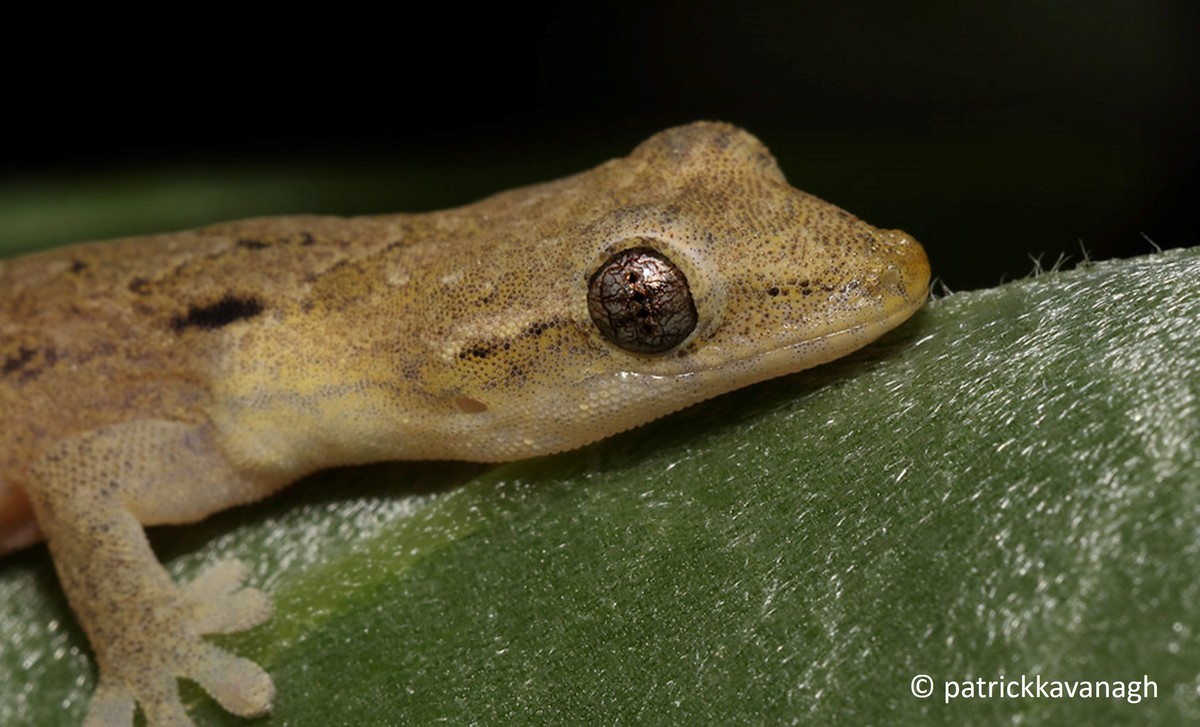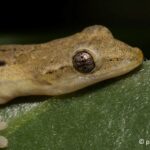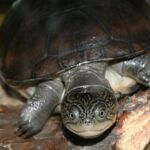
- Common name: Mourning gecko, Common Smooth-scaled gecko
- Scientific name : Lepidodactylus lugubris (Duméril & Bibron, 1836)
- Local name: Gecko nain, Gecko demi-deuil
- Order : Typhlopidae
- Family : Squamata
Description
Morphology. The Mourning gecko is a small sized, light-coloured gecko characterised by the presence of claws on four out of five fingers (absent on the thumb), a smooth-looking body without tubercles, with a dorsal pattern consisting of black symmetrical spots, sometimes discrete, « V » or « W » shaped, or in the form of dots. The base of the tail is slightly enlarged (HerpMe, Société Herpétologique de France).
Standard body size (snout-vent length). 33 to 48 mm (Ineich and Ota, 1993; Hoogmoed and Avila-pires, 2015; Sakai, 2016).
Sexual dimorphism. No significant sexual dimorphism. Males have two hemipenes, femoral pores, and external testes (Brown and Murphy-Walker, 1996; Saiko and Ota, 1998; Röll and Düring, 2008).
Variations. The body colour of the same individual can vary from light to dark, depending on its physiological condition.
Possible confusions with other species. In the Lesser Antilles, confusion is possible with another exotic gecko species, the House Gecko Hemidactylus mabouia. However, the House Gecko is characterised by the presence of claws on each finger, a body covered with tubercles, and six longitudinal rows of thorny tubercles on the tail (HerpMe, Société Herpétologique de France).
Distribution
Native. Asia: Taiwan, China, Chagos archipelago, Sri Lanka, India (and Adaman islands), Seychelles, Myanmar, Western Malaysia (Pulau Pinang, Pulau Tioman), Vietnam, Japan (Ryukyu, Bonin, Ogasawara, Okinawa, Miyako, Yaeyama and Daito), Indonesia (Borneo, Lombok, Sulawesi, Halmahera, Ambon, Kei, Komodo, Flores, Morotai), Philippines (Panay, Luzon, Cebu), Palau, New Guinea, Bismarck archipelago, Nauru, Salomon Islands, Micronesia (Lukunor Atoll), Fiji, Rotuma, New Caledonia, Loyauté island, Vanuatu, Toga, Tegua, Hiu, Marianna islands (Hileman et al., 2020), Cook island (Roratonga), Tonga, Australia, Maldive islands, Samoa, Guam, Société archipelago, Mascarenes (Rodrigues) (Nania et al., 2020).
Introduced. Hawai, Florida (Hoomgoed and Avila-Pires, 2015), Mexico (Ahumada-Carillo and Weatherman, 2018), Nicaragua (Sunyer et al., 2013), Costa-Rica, Panama, Brazil, Ecuador (including Galapagos), Colombia (including San Andres, Providencia, Islas del Rosario, Bolivar) (Hoomgoed and Avila-Pires, 2015; Señaris et al., 2017), Chile (Urra et al., 2020), Surinam, Venezuela (Señaris et al., 2017).
Caribbean: Bahamas (Paradise Island) (Krysko and MacKenzie-Krysko 2016; Liebgold et al., 2019), Cuba (Bosch and Paez, 2017), Cayman islands (Goetz and Burton 2018), Turks and Caïcos (Ruhe and Ruhe, 2019), Guadeloupe (Lorvelec et al., 2017; Borroto-Paez, 2018), Trinidad, Tobago (Auguste and Fifi, 2020), Curaçao (Behm et al., 2019).
Biology and ecology
Habitat. The global distribution of the species reflects its preference for a tropical to sub-tropical climate. The Mourning Gecko is able to cope with a great variety of natural and anthropized habitats. The species is found in mangroves and coastal environments, in humid forests, but also in urban and in peri-urban areas where artificial lighting, through attracting insects, provides an easily accessible and abundant source of food (Hoogmoed and Avila-Pires, 2015).
Diet. Nectarivore, frugivore and insectivore (Perry and Ritter, 1999; Nafus, 2012).
Reproduction. The Mourning gecko is a parthenogenetic species (Griffing et al., 2019), meaning that females lay eggs that develop without the need to be fertilised. Males are rare, and all the studied specimens have been found to be sterile (Brown and Murphy-Walker, 1996; Saiko and Ota, 1998; Röll and Düring, 2008). Several clonal lineages have been identified and described. At least two of these lineages arose from hybridisation events with Lepidodactylus moestus (Radtkey et al., 1995) and L. pantai (Karin et al., 2021).
Females can reproduce after five to nine months, and then breed throughout the year (Brown and O’Brien 1993; Griffing et al. 2018 2019). Two eggs are laid and hatching occur after approximately two months of incubation (65 days at 25.5° C to 103 days at 22° C; Brown and Duffy, 1992). Griffing et al. (2018) indicate an average number of 50 eggs produced each month from a pool of 60 individuals.
Behaviour. Females are more aggressive than males (Brown and Murphy-Walker, 1996). This aggressiveness, like the propensity to interact with other individuals (of the same or closely related species), is variable among lineages (Short and Petren, 2008; Murakami and Hayashi, 2018). Individual personality traits (such as shyness vs. boldness) are also variable depending on the habitat (Sakai, 2019).
Impact and management of introduced populations
Impact. Little is known about the impact of the Mourning Gecko on native ecosystems in introduced regions.
Management. To date, no targeted control measures have been established in the different regions where the species has been introduced.
Bibliography
- Ahumada-Carillo, I. T., & Weatherman, G. N. (2018). A confirmed established population of Lepidodactylus lugubris (Duméril and Bibron, 1836) (Squamata: Gekkonidae) in Mexico. Mesoamerican Herpetology 5: 154–157.
- Auguste, R. J., & Fifi, A. (2020). Additional record of the invasive mourning gecko Lepidodactylus lugubris (Duméril and Bibron, 1836) from Trinidad and Tobago, with comments on citizen science observations. Herpetology Notes 13: 1111–1112.
- Behm, J. E., Van Buurt, G., DiMarco, B. M., Ellers, J., Irian, C. G., Langhans, K. E., … Helmus, M. R. (2019). First records of the mourning gecko (Lepidodactylus lugubris Duméril and Bibron, 1836), common house gecko (Hemidactylus frenatus in Duméril, 1836), and Tokay gecko (Gekko gecko Linnaeus, 1758) on Curaçao, Dutch Antilles, and remarks on their Caribbean di. BioInvasions Records 8: 34–44.
- Borroto-Páez, R. (2018). High Abundance of the Introduced Mourning Gecko (Lepidodactylus lugubris) in Southwestern Grande Terre, Guadeloupe, French West Indies. IRCF Reptiles and Amphibians 25: 184–187.
- Bosch, R. A., & Páez, R. B. (2017). First record from Cuba of the introduced mourning gecko, Lepidodactylus lugubris (Duméril and Bibron, 1836). BioInvasions Records 6: 297–300.
- Brown, S. G., & Duffy, P. K. (1992). The effects of egg-laying site, temperature, and salt water on incubation time and hatching success in the gecko Lepidodactylus lugubris. Journal of Herpetology 26: 510.
- Brown, S. G., & Murphy-Walker, S. (1996). Behavioural interactions between a rare male phenotype and female unisexual Lepidodactylus lugubris. Herpetological Journal 6: 69–73.
- Brown, S. G., & O’Brien, J. (1993). Pseudosexual and dominance behaviour: their relationship to fecundity in the unisexual gecko, Lepidodactylus lugubris. Journal of Zoology 231, 61–69.
- Goetz, M., & Burton, F. J. (2018). First record of the mourning gecko, Lepidodactylus lugubris (Duméril & Bibron 1836), on Grand Cayman, Cayman Islands. IRCF Reptiles and Amphibians 2, 158–159.
- Griffing, A. H., Sanger, T. J., Daza, J. D., Nielsen, S. V., Pinto, B. J., Stanley, E. L., & Gamble, T. (2019). Embryonic development of a parthenogenetic vertebrate, the mourning gecko (Lepidodactylus lugubris). Developmental Dynamics 248, 1070–1090.
- Griffing, A. H., Sanger, T. J., Matamoros, I. C., Nielsen, S. V., & Gamble, T. (2018). Protocols for husbandry and embryo collection of a parthenogenetic gecko, Lepidodactylus lugubris. Herpetological Review 49, 230–235.
- Haubrock, P. J., Cuthbert, R. N., Veselý, L., Balzani, P., Baker, N. J., Dick, J. T. A., & Kouba, A. (2020). Predatory functional responses under increasing temperatures of two life stages of an invasive gecko. Scientific Reports 10, 1–10.
- Heinicke, M. P., Greenbaum, E., Jackman, T. R., & Bauer, A. M. (2012). Evolution of gliding in Southeast Asian geckos and other vertebrates is temporally congruent with dipterocarp forest development. Biology Letters 8, 994–997.
- Hoogmoed, M. S., & Avila-Pires, T. C. S. (2015). Lepidodactylus lugubris (Duméril & Bibron 1836) (Reptilia: Gekkonidae), an introduced lizard new for Brazil, with remarks on and correction of its distribution in the New World. Zootaxa 4000, 90–110.
- Ineich, I., & Ota, H. (1993). Morphological variation and distribution of the unisexual-bisexual complex of the gecko, Lepidodactylus lugubris, in French Polynesia and Easter Island. Bulletin of the College of Science, University of Ryukyus 56, 113–120.
- Karin, B. R., Oliver, P. M., Stubbs, A. L., Afirin, U., Iskandar, D. T., Arida, E., … Fischer, R. N. (2021). Who’s your daddy? On the identity and distribution of the paternal hybrid ancestor of the parthenogenetic gecko Lepidodactylus lugubris (Reptilia: Squamata: Gekkonidae). Zootaxa 4999, 87–100.
- Krysko, K. L., & MacKenzie-Krysko, C. (2016). First report of the Mourning Gecko, Lepidodactylus lugubris (Duméril & Bibron 1836), from The Bahamas. Caribbean Herpetology 54, 1–2.
- Liebgold, E. B., Liebgold, H. L., Ransom, M. J., & Ransom, T. S. (2019). The spread of the parthenogenetic mourning gecko, Lepidodactylus lugubris (Duméril and Bibron, 1836) to paradise island, the Bahamas, with comments on citizen science observations of non-native herpetofauna. BioInvasions Records 8, 45–49.
- Lorvelec, O., Barré, N., & Bauer, A. M. (2017). The status of the introduced Mourning Gecko (Lepidodactylus lugubris) in Guadeloupe (French Antilles) and the high probability of introduction of other species with the same pattern of distribution. Caribbean Herpetology 57, 1–6.
- Murakami, Y., & Hayashi, F. (2018). Behavioral interactions for food among two clones of parthenogenetic Lepidodactylus lugubris and sexually reproducing Hemidactylus frenatus geckos. Current Herpetology 37, 124–132.
- Nafus, M. G. (2012). Lepidodactylus lugubris. Foraging movement. Herpetological Review 43, 134–135.
- Nania, D., Flecks, M., & Rödder, D. (2020). Continuous expansion of the geographic range linked to realized niche expansion in the invasive Mourning gecko Lepidodactylus lugubris (Duméril & Bibron, 1836). PLoS ONE 15, 1–16.
- Oliver, P. M., Brown, R. M., Kraus, F., Rittmeyer, E., Travers, S. L., & Siler, C. D. (2018). Lizards of the lost arcs: Mid-Cenozoic diversification, persistence and ecological marginalization in the west pacific. Proceedings of the Royal Society B: Biological Sciences, 285.
- Perry, G., & Ritter, M. (1999). Lepidodactylus lugubris (Mourning gecko). Nectivory and daytime activity. Herpetological Review 30, 166–167.
- Radtkey, R. R., Donnellan, S. C., Fisher, R. N., Moritz, C., Hanley, K. A., & Case, T. J. (1995). When species collide: The origin and spread of an asexual species of gecko. Proceedings of the Royal Society B: Biological Sciences 259, 145–152.
- Röll, B., & von Düring, M. U. G. (2008). Sexual characteristics and spermatogenesis in males of the parthenogenetic gecko Lepidodactylus lugubris (Reptilia, Gekkonidae). Zoology 111, 385–400.
- Ruhe, B., & Ruhe, A. (2019). First record of the Mourning Gecko, Lepidodactylus lugubris (Duméril & Bibron), from the Turks and Caicos Islands with additional observations from the Bahamas. Caribbean Herpetology 66, 1–3.
- Saiko, Y., & Ota, H. (1998). Discovery of a Male Phenotype of the Parthenogenetic Gecko, Lepidodactylus lugubris, on Ishigakijima Island of the Yaeyama Group, Ryukyu Archipelago. Japanese Journal of Herpetology 17, 152–155.
- Sakai, O. (2016). Size distribution suggests a seasonal effect on reproduction of Lepidodactylus lugubris on Okinawajima Island, Japan, the northernmost distributional Area. Current Herpetology 35, 59–63.
- Sakai, O. (2019). Behavioural tendencies associated with microhabitat use in a clonal gecko species living in the wild. Behavioral Ecology and Sociobiology 73.
- Señaris, C., Rojas-Runjaic, F. J. M., Aristeguieta, M. M., & García-Señaris, G. (2017). Second record of the invasive gecko Lepidodactylus lugubris (Duméril & Bibron, 1836) (Squamata: Gekkonidae) from Venezuela. Check List 13, 2009–2012.
- Short, K. H., & Petren, K. (2008). Boldness underlies foraging success of invasive Lepidodactylus lugubris geckos in the human landscape. Animal Behaviour 76, 429–437.
- Sunyer, J., Nicholson, K. E., Phillips, J. G., Gubler, J. A., & Obando, L. A. (2013). Lizards (Reptilia: Squamata) of the Corn Islands, Caribbean Nicaragua. Check List 9, 1383–1390
- Urra, F. A., Zúñiga, A., Miranda-Calle, A. B., & Melero, N. (2020). First record of the invasive gecko, Lepidodactylus lugubris Duméril & Bibron, 1836 in mainland Chile (Squamata, Gekkonidae). Herpetozoa, 33, 125–129.





